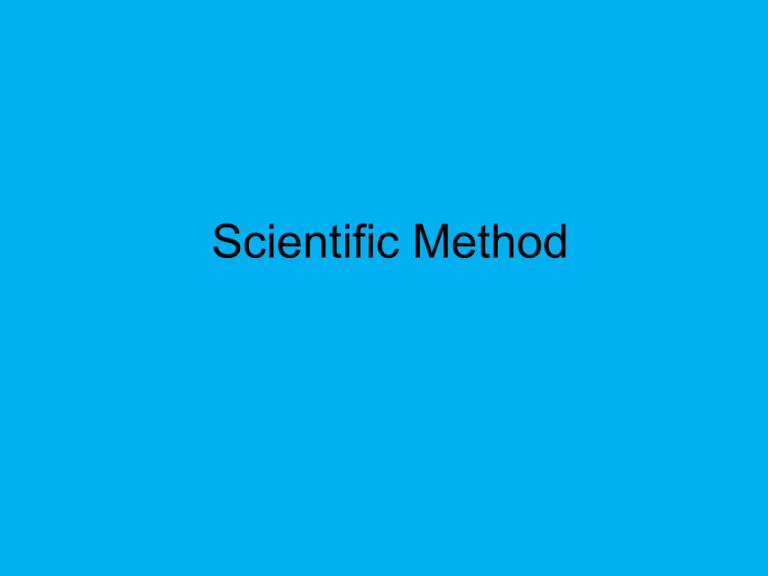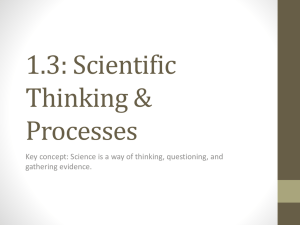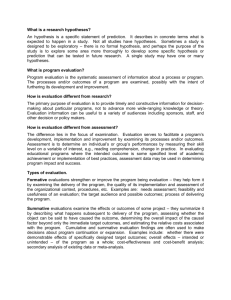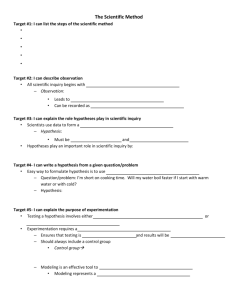Scientific Method
advertisement

Scientific Method Where do you get your facts? •Media •TV •Newspaper •Radio •Internet •Authority Figures •Parents •Teachers •Peers •Community Leaders •Government Officials •Your Conscience •Common sense •Intuition Limitations of your Methods •Media •TV – University of Maryland Study •Newspaper – NY Times •Radio – NCLB Scandal •Internet – Any slob can have a webpage •Authority Figures •Parents – biased and problems with above •Teachers – biased and problems from above • Peers – Anecdote learning •Community Leaders – How truthful? •Government Officials – Can you say WMD? •Your Conscience •Common sense – Hindsight Bias •Intuition – Overconfidence Are We Too Good at Making Connections? •Illusionary Correlation: •Two things seem related but something else is at play •We are good at finding a connection where none exists •Adoption and pregnancy •Plane crashes and terrorism •Superstition in Baseball •Perceptual Closure: •We MUST fill in the gaps •Problem with literacy What about Scientific Facts? True or False? 1. Opposites attract. 2. Within days newborns can recognize their mothers odor and voice. 3. Most mothers are depressed after their children leave home. 4. Massive loss of brain tissue early in life has dramatic long-term effects. 5. Prolonged stress reduce the body’s ability to fight disease. 6. ECT is very effective for severe depression. 7. All of our past experiences are recorded in our brains. 8. Hypnosis can awaken repressed experiences. 9. Men undergo a midlife crisis. 10. Diverse groups, young/old, rich/poor/ handicapped/healthy have the same % of well being. 11. Pigs sweat. 12. High fat diets increase the risk for Breast Cancer. 13. The Atkins diet increases LDL (bad cholesterol). The Scientific Approach •Conduct Accurate, Controlled, Objective Experiments •Do Not take anything on Faith •Report the Results to their Peers •Test Hypotheses and Theories Rigorously •Do NOT Protect Ideas •Engage in an Open System to Exchange Ideas •Peer Review Literature Scientific Attitude •Curious Skepticism •A scientist must always be questioning the status quo •And even their own findings “To begin with certainty we must begin by doubting” •Humility •True Scientists are after the truth •The key to conducting true science is to be objective •And one can only be objective if you possess humility The Greatest Skeptic •Math Professor in Pisa •Invented the telescope, studied the stars •confirmed that the earth must be rotating •Adopted Copernican Hypothesis - heliocentric •not popular in Roman Catholic Italy “false and absurd”, •earth was the center of the solar system •Aristotle/Ptolemy •Pope Urban VIII allowed him to publish a book •debating the Copernican Hypothesis •Was put before the Roman Inquisition for: “believing and holding doctrines that are false and contrary to divine scriptures” •He was forced to plead guilty and denounce his theories, yet under his breath he claimed… “Epur si muove” (And yet it does move) Galileo (1564-1642) Critical Thinking •Examine Assumptions •scientists must challenge the existing ways of thinking (Dogma) •if they wish to make a breakthrough •Identify Hidden Values •there are no negative results •an objective scientist leaves his/her biases behind •She/He learns to read between the lines of the data •Objectively Evaluate Evidence •this is critical to finding the Empirical Truth •Assess Conclusions •must be careful not to make too many assumptions about their data •most scientists are cautious about their initial findings •until repetition can make them stronger The Goals of Science •Describe Behavior •careful observation with experimentation •Predict Behavior •once observed with some regularity •Determine the Cause of Behavior •What is the driving force behind the behavior •Explain Why Behavior Occurs •So as to prevent abnormal behavior from occurring The General Types of Science •Basic Research •tries to answer fundamental questions about the nature of behavior •e.g., How does HIV invade a T cell? •Applied Research •Addresses issues where there are practical problems and solutions •e.g., How do we stop the spread of HIV in Southeast Asia? Why you need this Course •To Graduate •To Evaluate Your Facts •To Read Critically •To Evaluate Methods •To Confirm Conclusions •To Enhance Many Careers •Science •Medicine •Education •Business •Politics •Public Policy •Law Enforcement Scientific Method Steps 1. A. 6. 1. B. Observation 2. 5. 3. 4. 1. A. Review of Literature •Shelved Periodicals •Psychological Abstracts •PsycInfo search •Literature Review Papers •Paper References •Other Search Engines •Internet Searches Components of a Journal Article •Title •Abstract •Introduction •Methods •Results •Discussion •References 1. B. Observations •Common Sense •things we tend to believe are true – tend not to be •Observation of the World Around Us •Personal opinions and experiences provide insight but are misleading •Existing Theories •Impose a framework on sets of hypotheses •Can exist dogmatically - call to upset dogma •Many supported hypotheses add strength to theory •Refuted hypotheses would weaken theory •Past Research •First step should always be to become familiar with the research •Best way to generate ideas •Can see inconsistencies or alternatives •Practical Problems •Can be initiated on how to correct a current problem 2. Formulate a Hypothesis •What is a Hypothesis? •An idea or question •A statement about something that may be true •A tentative idea or question that is waiting for evidence to support it •It can be stated in formal or informal terms •It is a testable prediction •It typically predicts a relationship between variables •It typically is generated from past research •Experiments are designed to test hypotheses •Hypotheses are Supported NOT Proven •Support via replication increases support 3. Design the Study Choosing a Research Method •Artificiality of Experiments •studies done in labs are artificial •can do field experiments but lose controls •Ethical and Practical Considerations •research design should be both ethical and practical •Participant Variables •can make all the difference in your design •age, gender, ethnicity... •Description of Behavior •not always addressed by the research design •Successful Predictions of Future Behavior •not always addressed by the research design •Advantages of Multiple Methods •to get a complete understanding you need multiple research methods 3. Data Collection •Presentation •Choosing Participants •Communication •Confidentiality •Data Collection •Data Entry •Data Analysis Data Collection •During the Sampling Process, Do NOT change: •the Survey •the Procedure •your Presentation •your means of Communication •any answers on the surveys •Keep all Surveys in the Same Secure Place •Number all the Surveys Presentation •Dress Professionally •Stand or Sit Straight •Use a Clipboard •Smile •Be Serious •Be Courteous •Work in Pairs Choosing Participants •Choice will vary based on needs •Approach in a friendly manner •Mention: •Student Project •Short Survey – 5 minutes •Anonymous •Show Confidential Method •Provide Pencil & Writing Surface •Do Debriefing Communication •Be Professional •Know your Study •Smile •Be Respectful •Be Thankful •Offer to Answer any and all questions Confidentiality •Can be the Main Factor in Truthful Answers •Show the Procedure •Have Device in View •Show Respect for Confidentiality •Follow the Procedure Data Entry •Should ALWAYS be done with TWO people •Go very slow •Double Check your work •Save your spreadsheet often •Create an Excel Spreadsheet •Create an SPSS Spreadsheet •Save on Data Sticks and Bring to Class •Make Back-Up and leave at Home 4. Data Analysis •Data Collection •Data Analysis •Graphs •Descriptive Statistics •Inferential Statistics •Conclusions 5. Publish, Replicate, Refine •Publish •To appropriate journal •Reviewed by group of scientific peers •Rarely is accepted on first try •Replicate •By self or by others •Rarely done •Refine •Either support or refute hypothesis •Typically refine either way 6. Building a Theory A theory is a related set of hypotheses that, taken together, form a broad-ranging, testable explanation about some fundamental aspect of the natural world. •has a broader breadth of application than a hypothesis. •is not “absolute truth” •but scientists are “relatively” certain it is correct. •1. Impossible to test all conditions. •2. This is where statistics and probability come in. •3. Scientists must put aside pride or bias by testing ideas. The fact that an idea, or even a theory, might be subject to change is a strength of science, not a weakness.





